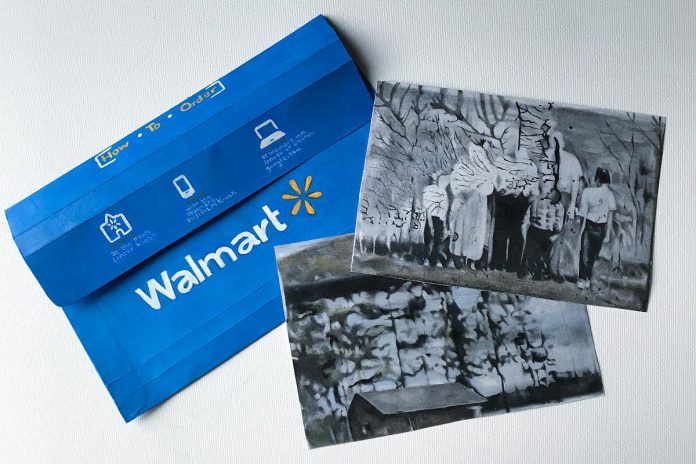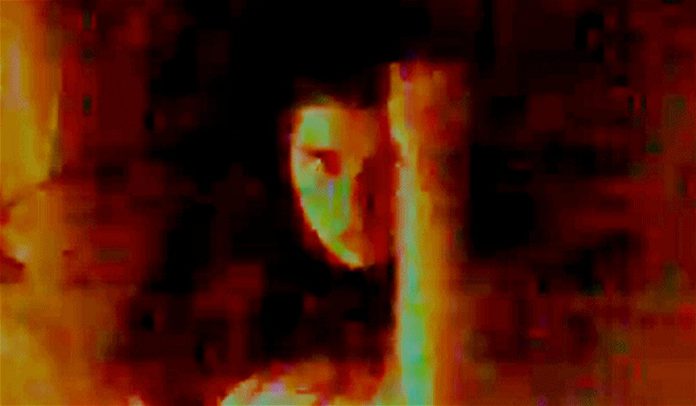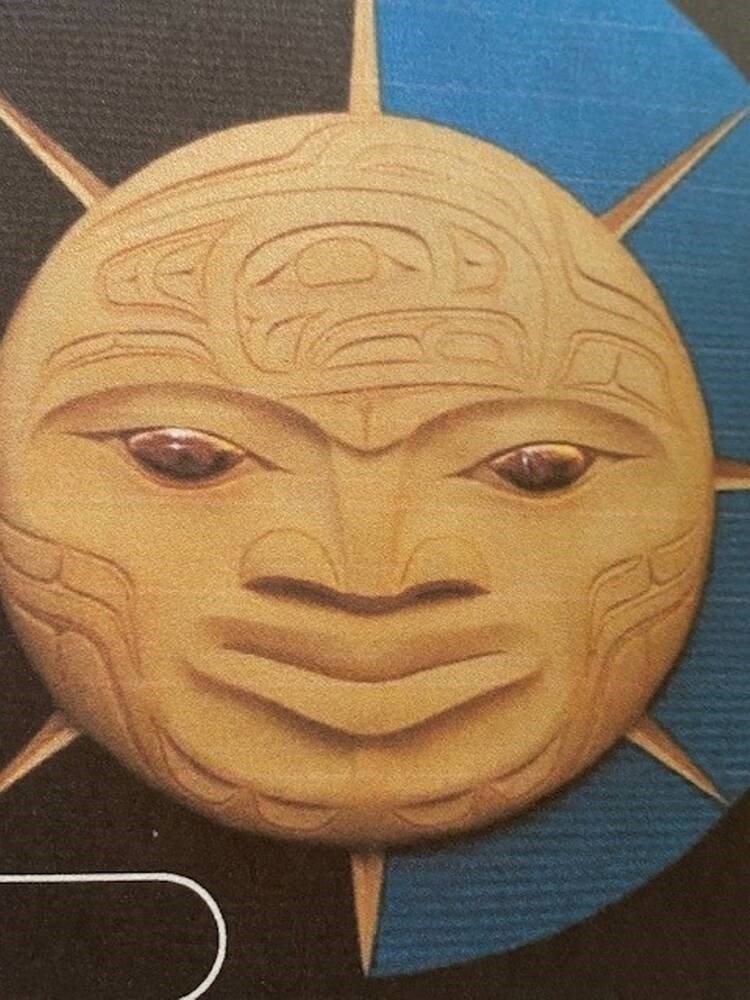Art
How digital art helped students at Peterborough's Trent University make the most of the pandemic – kawarthaNOW.com

Though Trent University in Peterborough lacks any official fine arts programs, the university’s Cultural Studies Department has a history of offering applied-arts courses and practical workshops. By merging theory and practice, the studio courses offer students the opportunity to think by doing; to critique and create culture.
During the COVID-19 pandemic, these applied-arts courses offered Trent students not only a unique approach to learning, but also a safe haven during an otherwise impossible time for students.
Culture X: Bodies in Nature, Bodies Online — a virtual exhibition available on Artspace Peterborough’s website until August 31 — features artworks created in some of Trent’s courses encompassing the Cultural Studies integrated arts platform.
Advertisement – story continues below
The online exhibition demonstrates the students’ innovative and insightful approaches to art making during the pandemic. Above all, however, the exhibit is a testament to the artists’ collective resiliency.
“I am very grateful for experiencing the Cultural Studies Department and classes the way I did,” says Raine Knudsen, whose stop-motion film ‘Connection’ plays with energy in movement.
“Despite everything that’s going on and despite all of the limitations that we’re facing, we’re still able to connect and we’re still able to nurture that part of ourselves and our human experience — even if it happens to be in different ways,” continues Knudsen.
“Being in the Cultural Studies Department during the pandemic has been really different from other departments,” adds Zoe Easton, who created a series of digital photographs entitled ‘Soft Places’.
“It is really hard to make art when you’re so overwhelmed by the world around you, but these courses were really good for encouraging us to put our personal experiences into the art,” Easton says. “For example, my project for this exhibit is about healing and specifically about the time that I took during the pandemic to go outside and be in nature.”
VIDEO: “Connection” by Raine Knudsen
[embedded content]
Indeed, many of the Culture X artists interviewed for this article spoke of the therapeutic elements they discovered through art making and community building.
“One of the most amazing things about this class was being able to see the perspective of all my classmates through their art,” recalls Shaun Phuah, whose video collage ‘People Looking at Me Looking at Them’ investigates the immediacy of the highly intimate and often-volatile personal spaces we see online.
“In a way, we were all dealing with the same things,” Phuah continues. “I thought it was just really touching to be able to experience that through the class and through my classmates in that way.”
“There is such a sense of community in the Cultural Studies department,” says Stephanie Etherington, whose major is in business administration.
“It was quite interesting to see other people’s interpretation of the pandemic within their work. We really fed off of one another’s energies and ideas,” says Etherington, whose series of digital photographs entitled ‘Captivating’ plays with colour, light, movement, and texture says. “It’s actually quite funny that the whole class ended up having this experience indulging in colour.”
Advertisement – story continues below
“We all sort of became friends,” explains Mridul Harbhajanka, whose playful musical composition ‘Spook-Key Tunes’ generates unique results, depending on the performers’ names, every time it is performed. “I created the piece during exam season. Having something fun to do between all these boring essays and exams was like a stress buster. This class played a huge role in how I view music. Without the course, I don’t think I would be able to come up with the idea for my composition.”
During a time when many artists have struggled or even resisted creating and disseminating digital art, the Culture X artists faced the challenges of digital art making head on.
“For a long time, I was trying to overcome the limitations of the digital,” explains Katy Catchpole, whose digital video ‘Own Undoing’ was awarded Trent’s prestigious Frith prize this year.
“It was almost a very negative approach — we were stuck in this pandemic, and we couldn’t be together, and we couldn’t produce art the way that we normally would — but I kind of got tired of that,” Catchpole says.
“I wanted to approach it from a more positive perspective, to think about how digital art can be manipulated, maybe in ways it wasn’t intended. So instead of thinking of digital art as this fixed static thing, I started to think about it more as painting or sculpture.”


For Carolina Engering and Ceilidh Peters, both students of the theatre course Performance and Protest, creating and presenting ‘Gender Inequality’ — their work of invisible theatre — online brought its challenges.
“Usually, invisible theatre is like a play, but the audience — the spectators — don’t know what’s happening,” Engering explains. “They don’t know there’s a play being performed, and they don’t know they’re part of the play. It’s experimental. It checks what they’ll do morally in a situation, usually involving oppression; it checks if they’ll be involved or not”
“Zoom was a huge challenge for us,” she continues. “We couldn’t go out in public, and invisible theatre is usually performed out in public in random areas, like a bus stop or something.”
“We originally set it up as being a presentation on gender inequality — that’s what the class thought they were watching — but the real performance we staged was this horribly racist attack towards one of the people in our group,” adds Peters.
Advertisement – story continues below
“Art really helps to humanize other people’s experiences,” Ceilidh concludes. “It helps people to visualize how other people live and be able to fully embrace the experiences that come with that.”
Though challenging, remote learning on Zoom increased accessibility for Culture X artist Jinian Raine, who has two works, ‘Ghosts’ and ‘Invisible Screen’, featured in the exhibit.
“I have a chronic illness and I’ve had one of the worst health years I’ve had in a very, very long time,” Raine explains.


“So if we hadn’t been on Zoom, I would not have been able to go to class,” Raine adds. “I was lucky that we were going through Zoom because I could do school from my bed, which is where I needed to do it.”
“Honestly, I think this class is possibly a pivotal moment in my life because I have kind of fallen in love with digital art and the art that I’ve made. This class has changed my life trajectory because of how much I fell in love with making art in it.”
To view the profound works of art that so strongly speak to the conditions in which they were created, Culture X: Bodies in Nature, Bodies Online can be accessed until August 31st on the Artspace website at artspace-arc.org/exhibition/culture-x-bodies-in-nature-bodies-online/.
Art
Art in Bloom returns – CTV News Winnipeg
Art
Crafting the Painterly Art Style in Eternal Strands – IGN First – IGN
Next up in our IGN First coverage of Eternal Strands, we’re diving into the unique and colorful art in the land of the Enclave. We sat down with art director Sebastien Primeau and lead character artist Stephanie Chafe to ask them all about it.
IGN: Let’s talk about Eternal Strands’ distinctive art style. What were some of the guiding principles behind the art direction?
Primeau: I think what was guiding the art direction at the beginning of the project was to find the scale of the game, because we knew that we were having those gigantic 25-meter tall creatures and monsters. So we really wanted to have the architectural elements of the game – the vegetation, the trees – to reflect that kind of size.
So one of my inspirations was coming from an architect called Hugh Ferriss, and I was very impressed by his work, and it was very inspiring for me too. So just the scale of his work. So he was a real influence for Metropolis, Gotham, so I was really inspired by his work.
Chafe: I think one of the things that, just as artists and as creators, we were interested in as well was going for a color palette that can be very bright. And something that can really challenge us too as artists, and going into a bit more of at-hand painterly work, and getting our hands really into it, into the clay, so to speak, and trying to go for something bright and colorful.
IGN: That’s not the first time I’ve heard your team describe the art style as “painterly.” What does that mean?
Primeau: Painterly is just a word that can give so much room to different types of interpretation. I think where we started was Impressionist painters. So I really enjoy looking at many painters, and they have different types of styles. But we wanted to have something that was fresh, colorful, and unique.
And also, I remember when we were starting the project there was that word. “It’s going to be stylized,” but stylized is just a word that gives so much room to different kinds of style. And since we were a small team, we had to figure out a way to create those rough brushstrokes. If it was painted very quickly by an artist, like Bob Ross would say, “Accident is normal.” So I think we wanted to embrace that. And because we’re all artists, it’s hard too, at some point, to disconnect from what you’re doing. It’s like, “Oh, I can maybe add some more details over there.” But I was always the- “Guys, oh, Steph, that’s enough. Let’s stop it right there. I think it looks cool.”
IGN: So, when you create an asset for Eternal Strands, is somebody actually painting something?
Chafe: I can speak more on the character side. For us, we do a lot of that hand painting, a lot of those strokes by hand. And we try to embrace, not the mistakes, but the non-realistic part of it having an extra splotch here and there.
We’ve got brushes that we made that can help us as artists to get the texture we’re looking for. It really is a texture that gives to it. But a lot of the time it’s not just something generated in a substance painter, or getting these things that will layer these things for you, making it quick and procedural. Sometimes we have those as helpers, but more often than not we just go in and paint.
IGN: Eternal Strands is a fair bit more colorful than lots of games today. Why was it important to the team to have lots of bright colors?
Primeau: You need to be careful, actually, with colors. Because with too many colors you can create that kind of pizza of color.
We wanted to balance the color per level, because we’re not making an open-world game. I really wanted each level to have their own color palette identity. So we’re playing a lot with the lighting. The lighting for me is key. It’s very important. You can have gorgeous textures, props, characters, but if your lighting is not that great, it’s like… So lighting is key. And especially with Unreal Five, we have now, access to Lumen. It brought so much richness to the color, how the color is balancing with the entirety of the level. It definitely changed the way we were looking at the game.
We’re using the technology, but in a way to create something that feels like if you were looking at a painting. I think we have achieved that goal.
Chafe: I’m very happy with it.
IGN: What were your inspirations from other games or other media when developing the art style?
Primeau: I have many. I’ll start with graphic novels, European graphic novels. I really wanted to stay away from DC comics, Marvels comics, those kinds of classics.
Before I started Eternal Strand, I saw a video. It was one of the League of Legends short films for a competition. It’s “RISE.” I don’t know if you remember that one, but it was made by Fortiche Studio who did Arcane, and I’m a huge fan of Arcane. When I saw that short film, it was way before Arcane was announced, I was like, “oh gosh, this is freaking cool. This is so amazing. I wish I would be able to work on a game that has that kind of look.”
Chafe: For me, when we started the project, one of the things that I wanted to challenge myself a lot was in concept and drawing and stuff like that and doing more, learning more about color as well, which is something I find super fascinating and also kicks my butt all the time because of just color theory in general.
But with the [character] portraits specifically, I think, I mean, growing up I played a lot of games, a lot of JRPGs too. I played just seeing basic portraits in something like Golden Sun or eventually also Persona and of course Hades, which is a fantastic game. I played way too much of that, early access included. But I really liked that part. Visual novels too, just that kind of thing. You can get an emotion from a 2D image as well when it’s well done, especially if you have voices on top of it.
IGN: Were there any really influential pieces of concept art that served as a guiding document the team would reference later on?
Chafe: I have one personal: It’s really Maxime Desmettre’s stuff because it was so saturated. Blue, blue, blue sky. Maxim Desmettre is our concept artist that we have who works from Korea. When I joined the project, seeing that was just like… and seeing that as a challenge too, like ‘how are we going to get there?’
The one that I’m thinking of that hopefully we could find after, just in general with the work that always speaks so much to me is this blue, blue sky and the saturation of the grass. But also when he gets into his architecture and stuff like that, there’s just a warmth to everything. The warmth to the stone that just makes it look inviting and mysterious at the same time. And I think that really speaks a lot to it.
IGN: How did you go about designing Eternal Strand’s protagonist: Brynn?
Primeau: I think that Mike also, when he pitched me the character, he was using Indiana Jones as an example. So courageous, adventurer guy, cool guy. Also, when you’re looking at Indiana Jones, he’s a cool guy. And we wanted to create that kind of coolness also out of our main protagonist. And I remember it took time. We did many iterations.
Chafe: It was a lot of iterations for sure. Well, I think I had done a bunch of sketches because it’s what’s going to be the face of the player, and also to have her own personality as well in the story, and her history as well. And the mantle was a really big one too. What gives her one of sets of her powers and stuff, figuring that out was actually one of the longest processes. It’s just a cape, but at the same time, it’s getting that to work with gameplay and all that kind of stuff. But yeah, all of Brynn’s personality and her vibe really comes from a lot of good work from the narrative team. So, mostly collaboration there.
IGN: What’s the deal with Brynn’s mentor: Oria? How did you settle on a giant bird?
Chafe: Populating the world of the enclave was, “it’s free real estate.” You get to just throw things on the wall and see what sticks. And, “Oh, that’s really cool. Oh, that’s nice.” At some point I’d done a big sketch of a big bird lady with a claymore, and Seb said, “That’s cool.” And then kind of ran with it.
IGN: What’s the toughest part about the art style you’ve chosen for Eternal Strands?
Primeau: The toughest part was…A lot of people in the team have experience making games, so it was to get outside of that mold that we’ve been to.
For me, working on games that were more realistic in terms of look, I think it was really tough just to think differently, to change our mindset, especially that we knew that we would be a small team, so we had to do the art differently, find recipes, especially when we were talking about textures, for example. So having a good mix.
Chafe: One of the things too is also as we’re all a bunch of artists, and every artist has their own style that they just suddenly have ingrained in them, and that’s what makes us all unique as artists as well. But when you’re on a project, you have to coalesce together. You can’t kind of have one look different from the other. When you’re doing something more realistic, you have your North Star, which is a giant load of references that are real. And you can say “it has to look like that, as close to that as possible.”
When you have a style in mind and you’re developing at the same time, you kind of look at it and you review it and you have a feeling more than anything else.
You’re training each other with your styles as you kind of merge together in the end. And that kind of is how the style happened through, like you mentioned, like finding easy recipes, through just actually creating assets and seeing what comes out and, “Oh, that’s really cool. Okay, we can now use that as kind of our North Star.”
For more on Eternal Strands, check out our preview of the Ark of the Forge boss fight, or read our interview with the founders of Yellow Brick Games on going from AAA studios to their own indie shop, and for everything else stick with IGN.
Art
Collection of First Nations art stolen from Gordon Head home – Times Colonist


Saanich police are investigating the theft of a large collection of First Nations art valued at more than $60,000 from a Gordon Head home.
The theft happened on April 2.
The collection includes several pieces by Whitehorse-based artist Calvin Morberg, as well as Inuit carvings estimated to be more than 60 years old.
Anyone with information on the thef is asked to call Saanich police at 250-472-4321.
jbell@timescolonist.com
-



 Investment12 hours ago
Investment12 hours agoUK Mulls New Curbs on Outbound Investment Over Security Risks – BNN Bloomberg
-



 Tech12 hours ago
Tech12 hours agoSave $700 Off This 4K Projector at Amazon While You Still Can – CNET
-



 Tech11 hours ago
Tech11 hours ago'Kingdom Come: Deliverance II' Revealed In Epic New Trailer And It Looks Incredible – Forbes
-



 Sports11 hours ago
Sports11 hours agoAuston Matthews denied 70th goal as depleted Leafs lose last regular-season game – Toronto Sun
-



 Science12 hours ago
Science12 hours agoJeremy Hansen – The Canadian Encyclopedia
-
Business9 hours ago
BC short-term rental rules take effect May 1 – CityNews Vancouver
-



 Investment9 hours ago
Investment9 hours agoBenjamin Bergen: Why would anyone invest in Canada now? – National Post
-
Art9 hours ago
Collection of First Nations art stolen from Gordon Head home – Times Colonist






